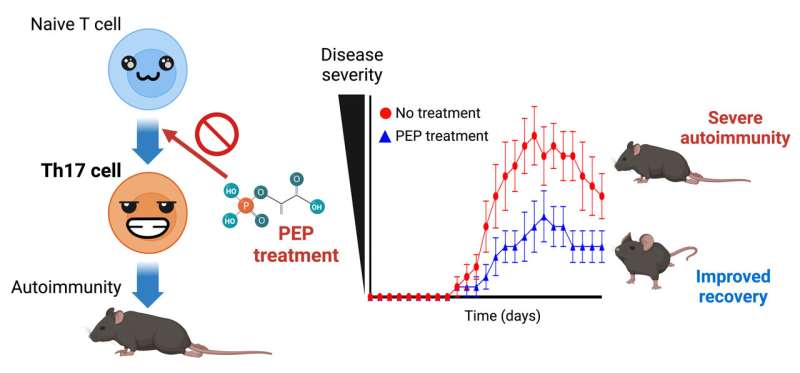This article has been reviewed according to Science X's editorial process and policies. Editors have highlighted the following attributes while ensuring the content's credibility:
fact-checked
peer-reviewed publication
trusted source
proofread
Potential treatment of autoimmune diseases revealed in new study

Scientists in Japan have revealed a chemical compound that could be used for the treatment of various autoimmune diseases like multiple sclerosis and rheumatoid arthritis. These diseases occur when the body's immune response goes awry. The immune system, which normally attacks pathogens and infections, instead attacks healthy cells and tissues. For the millions of people who suffer from autoimmune diseases worldwide, the result can be debilitating—rheumatoid arthritis causes excessive joint pain, while multiple sclerosis can disable one's brain and spinal cord function.
"The key to the development of autoimmune diseases, and thus the way to inhibit this development, lies in our cells, but the underlying mechanism has always been unclear," stated Prof. Hiroki Ishikawa, who leads the Immune Signal Unit at the Okinawa Institute of Science and Technology (OIST). "Now, our recent research has shed light on a compound that could suppress the development of these diseases."
Prof. Ishikawa went on to explain that this research, published in Cell Reports, could lead to the development of treatments for autoimmune diseases.
The research focused on T helper 17 cells, or Th17 cells. Th17 cells are a type of T cell—a group of cells, which form major parts of the immune system. These cells, which exist in high numbers in our guts, evolved to help us fight invasive pathogens but, sometimes, they're overactivated and mistake normal, healthy tissue as pathogens, resulting in autoimmunity. The generation of Th17 cells requires glycolysis, a metabolic process in which glucose is broken down and converted to energy to support the metabolic needs of cells. Glycolysis is essential for the growth of not only Th17 cells but also a variety of cells in our body.
"What's interesting in that excessive glycolysis seems to suppress Th17 cell activity," stated first author, Mr. Tsung-Yen Huang, a Ph.D. candidate in the Immune Signal Unit. "So, we hypothesized that molecules produced during glycolysis may inhibit the cells."
Enter phosphoenolpyruvate, or PEP for short. This chemical compound is a metabolite produced when glucose is converted to energy. Since it is part of such an important process, PEP is generated every day in our bodies. The researchers found that treatment with PEP can inhibit the maturation of TH17 cells, leading to resolution of inflammatory response.
Huang explained how this was, at first, a confusing result, as it went against all other research on the topic, but he decided to persevere and take a closer look at what could be occurring.
The research led them to a protein called JunB, which is essential for the maturation of Th17 cells. JunB promotes Th17 maturation by binding to a set of specific genes. The researchers found that PEP treatment inhibits the generation of Th17 cells by blocking JunB activity.
Armed with this knowledge, the researchers went on to treat mice that had neuroinflammation caused by autoimmunity with PEP. This disease is very similar to multiple sclerosis and these mice showed positive signs of recovery. The scientists have now filed a patent to continue with this research.
"Our results show the clinical potential of PEP," explained Huang. "But first we need to increase its efficiency."
In the past, researchers who were interested in developing a treatment for autoimmune diseases, often looked at inhibiting glycolysis and thus Th17 cells. But glycolysis is essential to various types of cells in the body and inhibiting it could have significant side-effects. PEP has the potential to be used as a treatment without resulting in such side-effects.
More information: Tsung-Yen Huang et al, Phosphoenolpyruvate regulates the Th17 transcriptional program and inhibits autoimmunity, Cell Reports (2023). DOI: 10.1016/j.celrep.2023.112205



















